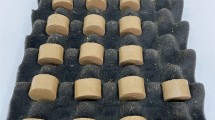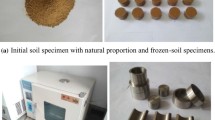Abstract
Understanding the mechanical characteristics of frozen soil is critical for engineering projects in cold regions. A series of case studies were conducted to explore the macroscopic and microscopic mechanical behavior of frozen soil during four different stress paths, i.e., isotropic, constant stress ratio, conventional triaxial, and true triaxial compression tests, using the distinct element method (DEM). The particle-scale mechanism and temperature effect of frozen soil are also taken into account in the DEM simulation. The results indicate that the peak stress/yield stress of frozen soil decreases with the increase of temperature or decrease of stress ratio or decrease of intermediate principal stress ratio b, which is related to the evolutions of bond breakage, bond stress, mechanical coordination number, and deviatoric fabric. When 0.25 ≤ b ≤ 0.75, the direction of strain increment deviates from the direction of stress. In addition, the relationship between the damage variable B and the volumetric strain εv or shear stain εs can be expressed as \(B=1-\mathrm{exp}(-a\cdot {\varepsilon }_{v}^{n})\) or \(B=1-\mathrm{exp}(-a\cdot {\varepsilon }_{s}^{n})\) under different stress paths. The simulation results and revealed microscopic mechanism will be valuable in develo** breakage-mechanics-based constitutive models for frozen soil.























Similar content being viewed by others
References
Barreto D, O'Sullivan C (2009) Zdravkovic L. Quantifying the evolution of soil fabric under different stress paths. Powders and Grains 2009: Proceedings of the 6th International Conference on Micromechanics of Granular Media: AIP Publishing, 181–184
Boyle RW, Sproule DO (1931) Velocity of longitudinal vibration in solid rods (ultrasonic method) with special reference to the elasticity of ice. Can J Res 5(6):601–618
Butkovich TR (1957) Linear thermal expansion of ice. U.S. Snow, Ice and Permafrost Research Establishment. Research Report 40.Google Scholar
Chen SJ, Ma W, Li GY, Liu EL, Zhang G (2017) Development and application of triaxial apparatus of frozen soil used in conjunction with medical CT. Rock Soil Mech 38(s2):359–367.In Chinese
Chen SJ, Ma W, Li GY (2021) A novel approach for characterizing frozen soil damage based on mesostructure. Int J Damage Mech 31(3):444–463
Ciantia MO, Arroyo M, Calvetti F, Gens A (2015) An approach to enhance efficiency of dem modelling of soils with crushable grains. Géotechnique 65(2):91–110
Cundall PA, Strack ODL (1979) A discrete numerical model for granular assemblies. Géotechnique 29(1):47–65
Dempsey JP, Wei YC (1989) Fracture toughness KQ and fractography of S1 type freshwater ice. In: ICF7. Houston (USA) 3421–3428
Farid H, Saeidi A, Farzaneh M (2017) Prediction of failure in atmospheric ice under triaxial compressive stress. Cold Reg Sci Technol 138:46–56
Gagnon RE, Gammon PH (1995) Triaxial experiments on iceberg and glacier ice. J Glaciol 41(139):528–540
Golding N, Schulson EM, Renshaw CE (2012) Shear localization in ice: mechanical response and microstructural evolution of P-faulting. Acta Mater 60(8):3616–3631
Gold LW (1958) Some observations on the dependence of strain on stress for ice. Can J Phys 36:1265–1275
Han HW, **e F, Wang EL, Zhang D (2018) Experimental study on properties of compressive strength and failure criteria of river ice under triaxial compression. J Hydraul Eng 49(10):1199–1206.in Chinese
Haynes FD (1978) Effect of temperature on the strength of snow-ice. Department of the Army, Cold Regions Research and Engineering Laboratory, Corps of Engineers, CRREL Report 78–27
Hohmann-Porebska M (2002) Microfabric effects in frozen clays in relation to geotechnical parameters. Appl Clay Sci 21(1–2):77–87
Itasca (2019) Particle flow code in three dimension (PFC3D), User’s Manual, Version 6.0. Itasca Consulting Group, Minneapolis.
Jiang MJ, Yu HS, Harris D (2006) Bond rolling resistance and its effect on yielding of bonded granulates by DEM analysis. Int J Numer Anal Methds Geomech 30(8):723–761
Jiang MJ, Sun RH, Arroyo M, Du WH (2021) Salinity effects on the mechanical behaviour of methane hydrate bearing sediments: A DEM investigation. Comput Geotech 133:104067
Lai YM, Yang YG, Chang XX, Li SY (2010) Strength criterion and elastoplastic constitutive model of frozen silt in generalized plastic mechanics. Int J Plast 26(10):1461–1484
Lai YM, Liao MK, Hu K (2016) A constitutive model of frozen saline sandy soil based on energy dissipation theory. Int J Plast 78:84–113
Lai YM, Xu XT, Yu WB, Qi JL (2014) An experimental investigation of the mechanical behavior and a hyperplastic constitutive model of frozen loess. Int J Eng Sci 84:29–53
Lainey L, Tinawi R (1984) The mechanical properties of sea ice — a compilation of available data. Can J Civ Eng 11:884–923
Liu EL, Lai YM (2020) Thermo-poromechanics-based viscoplastic damage constitutive model for saturated frozen soil. Int J Plast 128:102683
Liu ZY (2018) Mechanical characteristics and microstructure mechanism of unsaturated soil subjected to freeezing condition. Bei**g Jiaotong University, Doctoral dissertation. In Chinese
Ma QY, Huang K, Ma DD, Yao ZM, Zhou ZX (2022) True triaxial tests on frozen sandy soil under different intermediate principal stress coefficients and negative temperatures. Chin J Geotech Eng 44(5):870–878 (In Chinese)
Ma W, Chang X (2001) Influence of loading and unloading on strength and deformation of frozen soil. Chin J Geotech Eng 23(5):563–566 (In Chinese)
Ma W, Chang X (2002) Analyses of strength and deformation of an artificially frozen soil wall in underground engineering. Cold Reg Sci Technol 34(1):11–17
Ma W, Wang D (2012) Studies on frozen soil mechanics in China in past 50 years and their prospect. Chin. J. Geotech Eng 34(4)625–640. In Chinese
Northwood TD (1947) Sonic determination of the elastic properties of ice. Can J Res 25a:88–95
O’Sullivan C (2011) Particle-based discrete element modeling: geomechanics perspective. Int J Geomech 11(6):449–464
Petrovic JJ (2003) Review mechanical properties of ice and snow. J Mater Sci 38(1):1–6
Potyondy D, Cundall P (2004) A bonded-particle model for rock. Int J Rock Mech Min 41(8):1329–1364
Qiu WL, Peng RX (2021) Research on the numerical simulation for plastic model of ice as building materials under triaxial compression. Constr Build Mater 268:121183
Satake M (1982) Fabric tensor in granular materials. Delft, Balkema. Proceedings of the IUTAM Symposi-um on Deformation and Failure of Granular Materials. [S.l.]: Delft, Balkema, 63–68
Shan RL, Bai Y, Sui SM, Yang H, Duan JM (2018) Experimental research on mechanical characteristics of freshwater ice under triaxial compression. J Basic Sci Eng 6(4):901–917. In Chinese
Shen MD, Zhou ZW, Zhang SJ (2021) Effect of stress path on mechanical behaviours of frozen subgrade soil. Road Materials and Pavement Design. 1–30
Shen ZJ (2003) Breakage mechanics for geological materials: an ideal brittle-elasto-plastic model. Chin J Geotech Eng 25(3):253–257 (In Chinese)
Sun K, Tang L, Zhou AN, LiNG XZ (2020) An elastoplastic damage constitutive model for frozen soil based on the super/subloading yield surfaces. Comput Geotech 128(103842):1–9
Sun XL, Wang R, Hu MJ (2005) A CT-timely experimental study on meso-scopic structural damage development of frozen soil under triaxial shearing. Rock Soil Mech 26(8):1298–1302,1311. In Chinese
Sun YG (2012) Experimental and numerical investigation on macro- and micro-mechanical behaviors of structural sands. Tongji University. Doctoral thesis
Tabata T, Fu**o K, Aota M (1967) Studies on the mechanical properties of sea ice: the flexural strength of sea ice in situ. Phys Snow Ice Proc 1(1):539–550
Thornton C (2000) Numerical simulations of deviatoric shear deformation of granular media. Geotechnique 50(1):43–53
Tsytovich NA, Sumgin MI (1937) Principles of mechanics of frozen ground. U s: SIPRE Transl 19:106–107
Vaudrey K (1977) Ice engineering— study of related properties of floating sea ice sheets and summary of elastic and viscoelastic analyses. U.S. Naval Civil Engineering Laboratory, Report TR860, Port Hueneme, CA
Wang GD, Clavetti F (2021) 3D DEM investigation of the resistance of ice and frozen granular soils. Eur J Environ Civ En 2021997:1–21
Wang JC, Zhang XZ (1996) Application of scanning electronic microscope in study of geocryology. J Glaciol Geocryol 18(2):184–188 (In Chinese)
Wu C, Zhang S, Zhou Z, Sun Z (2016) A study of the effect of confining pressure path on strength and deformation of frozen silty sand. J Glaciol Geocryol 38(6):1575–1582 (In Chinese)
Wu ZW, Ma W, Pu YB, Chang XX (1997) Submicroscopic analysis on deformation characteristics in creep process of frozen soil. Chinese Journal of Geotechnical Engineering 19(3):4–9 (In Chinese)
Xu G, Wu W, Kong L, Qi J (2018) Hypoplastic modeling for the mechanical behavior of frozen soil in stress path testing. Int J Geomech 18(6):04018049
Xu HY, Lai YM, Yu WB, Xu XT, Chang XX (2011a) Experimental research on triaxial strength of polycrystalline ice. J Glaciol Geocryol 33(05):1120–1126.in Chinese
Xu X, Lai Y, Liu F, Chang X, Dong Y (2011b) A study of mechanical test methods of frozen soil. Journal of Glaciology and Geocryology 33(5):1132–1138
Xu X, Yuan J, Bai R (2014) Laboratory investigation on mechanical behavior of artificial ice under triaxial compression. Adv Mater Res 887–888:903–906
Xu XZ, Wang JC, Zhang LX (2001) Permafrost physics. Science Press, Bei**g (In Chinese)
Yamamoto Y, Springman SM (2019) Triaxial stress path tests on artificially prepared analogue alpine permafrost soil. Can Geotech J 56(10):1448–1460
Yang Z, Still B, Ge X (2015) Mechanical properties of seasonally frozen and permafrost soils at high strain rate. Cold Reg Sci Technol 113(7):12–19
Zhang D, Liu E (2019) Binary-medium-based constitutive model of frozen soils subjected to triaxial loading. Res Phys 12:1999–2008
Zhang FG (2017) A study on the three-dimensional constitutive model for structured sands based on the micro-mechanism of structure degradation. Tongji University. Doctoral thesis
Zhou ZW, Ma W, Zhang SJ, Mu YH, Li GY (2020) Experimental investigation of the path-dependent strength and deformation behaviours of frozen loess. Eng Geol 265(105449):1–13
Zhou ZW, Ma W, Zhang SJ, Du HM, Mu YH, Li GY (2016) Multiaxial creep of frozen loess. Mech Mater 95:172–191
Zhou FX, Lai YM (2010) Simulation of mechanical behaviour for frozen sand clay by discrete element method. Rock and Soil Mechanics 31(12):4016–4020 (In Chinese)
Zhou JZ, Wei CF, Wei HZ, Tan L (2014) Experimental and theoretical characterization of frost heave and ice lenses[J]. Cold Reg Sci Technol 104–105:76–87
Funding
The work in this paper was financially supported by the National Outstanding Youth Science Fund Project of National Nature Science Foundation of China with Grant No. 51825904, which is sincerely appreciated.
Author information
Authors and Affiliations
Corresponding author
Ethics declarations
Conflict of interest
The authors declare no competing interests.
Rights and permissions
Springer Nature or its licensor (e.g. a society or other partner) holds exclusive rights to this article under a publishing agreement with the author(s) or other rightsholder(s); author self-archiving of the accepted manuscript version of this article is solely governed by the terms of such publishing agreement and applicable law.
About this article
Cite this article
Sun, R., Liu, R., Zhang, H. et al. DEM investigation of the mechanical behavior of frozen soil along various stress paths. Bull Eng Geol Environ 82, 351 (2023). https://doi.org/10.1007/s10064-023-03367-1
Received:
Accepted:
Published:
DOI: https://doi.org/10.1007/s10064-023-03367-1




